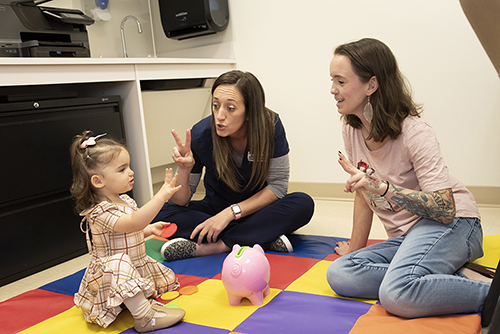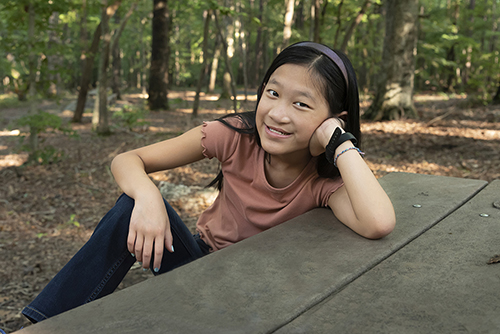Smiling, Together
Duke Cleft and Craniofacial Center provides continuous care for every stage
By Miriam Sauls
Photography by Les Todd
Published as part of the Winter 2023 issue of Duke Children's Stories
“The day I realized my baby had a cleft, I bawled my eyes out,” recalls Michael Gurley, mother of Madison Beaudry. At her 16-week ultrasound, Gurley knew what she was looking at because she, too, was born with a cleft. “I called my mom crying and said, ‘Mama, I don’t know how I’m going to feed her.’”
Cleft lip and/or cleft palate is one of the most common birth defects in the United States, affecting approximately 1 in 700 babies. A cleft happens if the tissue that composes the lip or palate does not join completely before birth.
Gurley began researching treatment options, and being from Raleigh, knew she would go to UNC or Duke. As a child, she had required more than a dozen surgeries, which dominated all her summers and extracurricular activities, so she was hoping for a very different life for Madison.
Duke invited her to a clinic day at the Duke Cleft and Craniofacial Center while she was still pregnant. She was astonished to see a cheerful place with children showing no visible signs of clefts. She knew she’d found her home for Madison’s care.
A TEAM APPROACH
The Duke Cleft and Craniofacial Center offers a full spectrum of care, ranging from prenatal consultations to surgery to continuous support for toddlers and children as they grow.
The clinic is a one-stop shop and provides the full range of specialty care, removing the pressure on parents to coordinate the providers that are needed. This can include, over the course of the child’s life: a plastic surgeon, a speech pathologist, a craniofacial orthodontist, an ENT doctor, an audiologist, and a social worker. After initial surgery, the family typically comes once a year and sees every member of the team.
Speech pathologist Carlee Jones serves as the coordinator of the clinic. “My job is to make parents’ lives as easy as possible and coordinate all their care so that it’s the least amount of burden on the family and the child,” says Jones.
“Cohesive care among a true team is super important and is one of the most crucial pieces to providing care to kids born with clefts,” says Jeffrey Marcus, MD, chief of the Duke Division of Plastic, Maxillofacial, and Oral Surgery, and the person who has built the current team since his arrival at Duke in 2002.
“It is typical to have team care, but not all teams are equal,” says Jones. “We are unique in that we are an extremely collaborative group. We all sit down together for a conference after each kid leaves and discuss that child.”
“Because a lot of these children are diagnosed prenatally and we meet with the parents before birth, we can provide education about what to expect,” says Jenny Kern, cleft team speech therapist. “We can tell parents that we are going to be here to support them from their child’s birth to young adulthood.”
The resources Gurley found available in December 2021, when Madison was born, are worlds apart from when she was a child. Some of these advancements are in technology and equipment, but much is in the holistic philosophy of treatment.

Gurley was thrilled that the clinic focused on care beyond surgery, especially on speech and feeding therapies. Babies born with a cleft palate are unable to generate the suction needed to extract milk while breastfeeding or from a standard bottle. Gurley’s mother told her that, when she was a baby, she had to sit her up and feed her with an eyedropper because she didn’t know what else to do.
The team of speech pathologists provide specific feeding strategies for success, including specialty bottles. They begin working with children in infancy and toddlerhood to produce speech before they develop habits that need to be reversed. Gurley didn’t begin speech therapy until she was 7, so she was delighted Madison would receive early intervention. Madison has been seeing Kern biweekly since she was 14 months old.
LETTING KIDS BE KIDS
A central goal of the team is to minimize surgical procedures, giving kids less time recovering and more time to be kids. The primary reason the team can achieve this is their use of nasoalveolar molding (NAM), a pre-surgical, custom-made orthopaedic appliance that brings together the two sides of a cleft lip and palate to narrow the cleft gap. It also forms and shapes the nose and facial structures to provide a more symmetrical appearance.
Shortly after birth, the craniofacial orthodontist and pediatric plastic surgeons evaluate the infant in clinic. If the child will benefit from NAM, a dental impression is taken of the infant’s mouth and then used to create a custom acrylic device that resembles an orthodontic retainer.
The device is placed in the newborn’s mouth and worn for 24 hours a day. Depending on the type and severity of the child’s cleft, the NAM appliance may remain in place for a few weeks or up to 6 months, with weekly adjustments in clinic.
Pedro Santiago, DMD, MBA, the team’s craniofacial orthodontist, helped develop the NAM technique in the 1990s at NYU. “The idea is to restore the normal anatomical relationship that was disrupted in utero and by doing that, when it’s time for the primary surgery, we knock it out of the park every single time,” says Santiago.
Madison got her NAM at 3 weeks old and had her first surgery to repair her lip at 4 months. She had her palate repair surgery combined with ear tube installation at 11 months old. After using the NAM device, her cleft was so close together that Marcus only utilized minimal tension on her tissue to close the cleft and create symmetry.
“Before her lip surgery, I was asked constantly what was wrong with my child,” says Gurley. “Now, since the scar isn’t noticeable at all, I can’t even remember the last time anyone mentioned anything unprompted.”
“The most important thing is that we reduce the need of revision surgeries in the future,” says Santiago. “When we have been to national and international meetings, we have not seen any other team that could achieve our results in the amount of surgeries we do.”
As lead global advisor in oral health for the international medical nonprofit Operation Smile, which provides care to children born with cleft conditions, Santiago is proud to share Duke’s methods of achieving outstanding results as he teaches throughout the world.
SUPPORT BEYOND SURGERY
Prenatal diagnosis and the ability to plan before birth is comforting to parents reeling from a diagnosis. But some children are unable to begin treatment immediately. Violet Ake was adopted from China at 17 months, but her parents were still able to get immediate help when she came home.
“We had photos from the adoption agency,” says Tripp Ake, Violet’s dad. “We reached out to potential places in the area and Dr. Marcus responded right away and gave us a very clear sense of what they would be able to do. Without Violet even being an established patient, the cleft team was very comforting, and we knew exactly what would need to be done and in what timeframe, so that solidified our choice of Duke.”
Violet has been a Duke patient ever since and has made strong connections with the team. “Carlee is someone Violet is very attached to and comfortable with, and she has created a lot of opportunities for Violet, including helping her become a published author,” Ake adds.
Violet, now 12, came to her annual appointment when she was 9 with a book made from folded notebook paper that illustrated a clinic visit with words and drawings. The team was so impressed they asked Violet if she wanted to collaborate on a book that could help other children know what to expect on clinic day. Jones and her team helped Violet publish the book, now available on Amazon, and every child who comes to clinic receives a copy.
“We took it very seriously, and we really put it in Violet’s hands. We let her drive the writing of it—we thought it was important to keep it true to her vision,” says Jones.
Violet likes that her book shows that kids shouldn’t be afraid, and that clinic can be fun. "I'm not feeling like I want to be rich from this,” says Violet. “I just want it to help other kids.”

"I'm not feeling like I want to be rich from this. I just want it to help other kids.”
CHANGING SMILES, CHANGING LIVES
The funds raised from the sale of Violet’s book benefit Smile Together, the brainchild of Chrissy Wrede, the parent of a child born with a cleft who wanted to support the clinic. She and Jones collaborated on the nonprofit, which advocates for the cleft and craniofacial community and works to eliminate stigma and empower members of the community.
Wrede’s son was born on World Smile Day, so for his first birthday in 2017, they set up their first Smile Stand, which sold lemonade and raised $1,200. Last year, Smile Together raised over $45,000, which benefits the Duke team and supports items like new equipment, charitable clinical care, and cleft community gatherings including an annual outing to a Durham Bulls game.
“Treating patients with craniofacial anomalies and their families is very fulfilling and I feel we are the ones that benefit the most,” Santiago says. “What an amazing privilege it is to be able to transform a child’s life doing the work we love to do. We are blessed.”
“Duke has made this a normal parenting journey,” says Gurley. ”It doesn’t feel like special-needs parenting. I don’t have to go to 20 doctors’ appointments and go through multiple surgeries with Madison like my mom had to do with me. I came home from my first day of school and told my mom I was the ugliest kid in the class. Madison will never have that feeling and is already speaking normally, thanks to speech therapy with Jenny. And she loves gymnastics and dance. She is not going to have to miss out on anything.”
YOUR GIFT CREATES A BRIGHTER FUTURE FOR CHILDREN IN NEED
We appreciate gifts of any size, making sure that your generosity is used to advance medical care and provide a better tomorrow for our children. You can choose a dollar amount to give now, or continue exploring more ways that you can support Duke Children’s.
